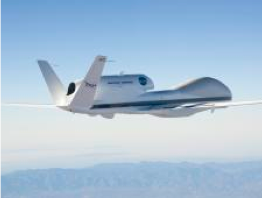By Dr. Charles Kironji Gatebe, NASA Scientist for GLOBE Student Research Campaign on Climate
The year is 2064 and you’re telling students how Unmanned Aircraft Systems (UAS) first made debut flights to make measurements of atmospheric composition, way, way up in the atmosphere at 20 km from the ground and flying for over 30 hours non-stop. Today, this sounds like a Wright brothers’ story that your teachers told you when you were young. The unmanned aircraft are now so commonplace that well-to-do families own at least one UAS for vacationing in the cosmos. The story sounds funny to the students hearing that NASA was just beginning to deploy UAS in field missions. NASA now have sophisticated UAS, which look like bats and have capability to fly anywhere anytime, and can be programmed on the fly to make any type of measurements needed by scientists. Actually, NOAA now uses them routinely to monitor the global environment.
The era of UAS in operational atmospheric research at NASA began in earnest in the year 2010. It was a very eventful year and remarkable in many ways. It was a year of El Niño (full name is El Niño-Southern Oscillation (ENSO)), which produced a lot of rain, floods, and other disturbances such as droughts in range of locations around the world. In the same year, earthquakes shattered records in Haiti where more than one hundred thousands lives were lost, while in Chile the 8.8 magnitude earthquake moved the entire city of Concepcion at least 10 feet to the west and shortened the length of the day by about one-millionth of a second. There was also so much talk about climate change, and the world political leaders could not agree on the steps needed to halt the rising CO2 levels that scientist had identified as the main cause of global warming. So, NASA had just announced that in a period of six weeks between March and April, scientists would deploy an unmanned aircraft system named Global Hawk, for the first time to a field experiment named GloPac (Global Hawk Pacific Mission). The mission would take place out of Dryden Flight Research Center in California, USA, and would cover the entire offshore Pacific region with four to five 30-hour flights. The purpose of this experiment would be to support validation of a satellite known as Aura, which carried instruments for measuring gases such as ozone, carbon monoxide and nitrogen oxides. A ground based crew would guide the aircraft from the equator to the Arctic Circle, as remotely controlled scientific payloads on board collected data on key regions of the atmosphere important in climate change and ozone layer research. Researchers on the ground would be able to watch their data arrive in near real-time via satellite link, and could redirect the aircraft to certain phenomena or regions of interest along the flight track. The lead scientist would communicate with the world via Blogs and share almost near real time the excitement of the new adventure of deploying science instrument on UAS for the first time in the history of NASA.
This first Earth science mission of the Global Hawk demonstrated the value of this unique and powerful resource to atmospheric science in the world. Those who witnessed the moment, can still remember the excitement.
Go, go, Global Hawk! Soar high!

